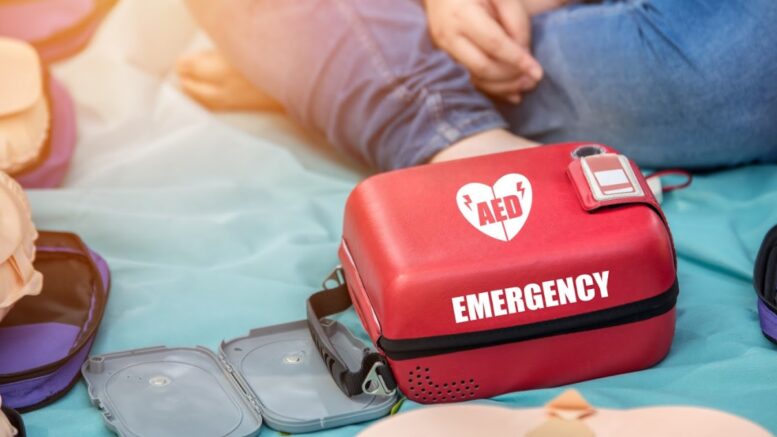Sudden cardiac arrest or SCA affects nearly half a million people every year—and the next person affected could be you or someone you love. When seconds count, we want the fastest, most effective life-saving tools, and that’s why public AEDs are crucial.
While cardiopulmonary resuscitation (CPR) has been proven effective, it’s not always enough to save lives. In these instances, devices like the CellAEDÆ personal defibrillator help people get the second chances they need. To understand the importance of AEDs in public places, let’s explore what they are and how they work.
What is an AED?
An AED or automated external defibrillator is a lightweight, handheld device that can save lives in emergencies. Automated external defibrillators are designed to help those in sudden cardiac arrest, which can lead to death if not treated promptly. When cardiac arrhythmia is detected, the AED sends electrical shocks through the chest and into the heart, restoring normal rhythm.
Reason #1: AEDs are Affordable and Easy to Use
Whether you’re trained or untrained, you can use a handheld AED to provide emergency care during a sudden cardiac arrest. AEDs are built to be used by anyone who can follow audible and visual instructions. Customers, gym patrons, employees, and others can step in and provide lifesaving shocks, even if they’ve never seen an AED. There are a range of choices for every budget and need, but the best defibrillator is the one that’s close at hand.
Reason #2: Fast Responses
When someone goes into cardiac arrest, seconds count. Numerous studies have shown that if defibrillation occurs within three to five minutes of an SCA, survival chances can be as high as 74%. Waiting for EMTs can take much longer, significantly reducing that figure.
Public AEDs are essential because they cut response times. By having defibrillators in communal spaces, bystanders can act while waiting for medical services to arrive. With rapid responses, we can give SCA patients better chances of survival.
Reason #3: Improved Outcomes for SCA Sufferers
Without quick AED treatment, most sudden cardiac arrest victims won’t survive. Studies show:
- Patients are more likely to live through a cardiac arrest if someone uses an AED while waiting for EMTs.
- Thousands of lives are saved every year from bystanders’ use of automated external defibrillators.
- When someone goes into cardiac arrest, every millisecond counts. According to the Red Cross, for each minute that treatment is delayed, the patient’s survival chances decrease by approximately 10%, dropping to nearly zero after 10 minutes. When AEDs are installed in more public places, we equip ourselves with the tools to save more lives.
Public AEDs Create Safer Communities
Beyond restating the importance of easy accessibility, we must focus on the need for building owners and managers to budget for defibrillator installation. Schools, libraries, and other places are the best places to deploy AEDs, and decision-makers should be made aware of the life-saving benefits of AED availability.
The more AEDs are installed in community centers, gyms, grocery stores, and other public places, the more lives will be saved. Business owners, citizens, and community leaders must advocate for and prioritize public AED placement.
Cardiac arrest can affect anyone at any time, but we’re more than capable of rising to the challenge. As we give community members the knowledge and equipment needed to save lives, we create a safer world where anyone can step in when help is needed.
Article edited and fact checked by our editorial team.
References:
- Folke F, Shahriari P, Hansen CM, Gregers MCT. Public access defibrillation: challenges and new solutions. Curr Opin Crit Care. 2023 Jun 1;29(3):168-174. doi: 10.1097/MCC.0000000000001051.
- Telec W, Baszko A, Dąbrowski M, et al. Automated external defibrillator use in public places: a study of acquisition time. Kardiol Pol. 2018;76(1):181-185. doi: 10.5603/KP.a2017.0199.
- Liu CH, Sung CW, Fan CY, Lin HY, Chen CH, Chiang WC, Ma MH, Huang EP. Strategies on locations of public access defibrillator: A systematic review. Am J Emerg Med. 2021 Sep;47:52-57. doi: 10.1016/j.ajem.2021.02.033. Epub 2021 Feb 27. PMID: 33770714.
